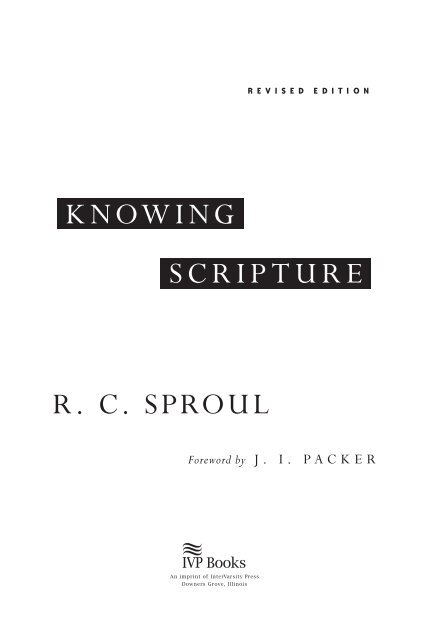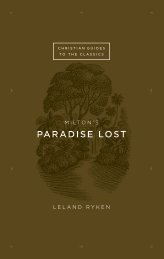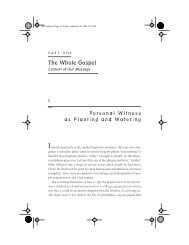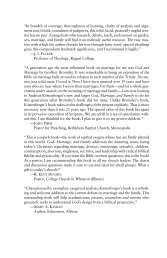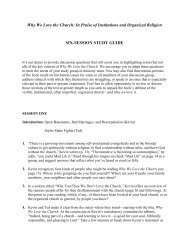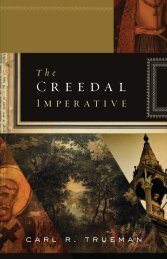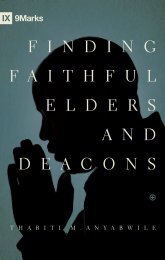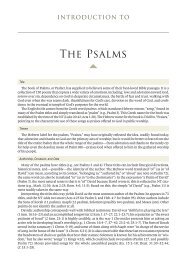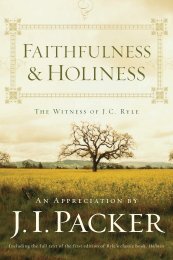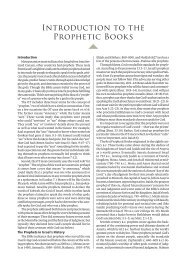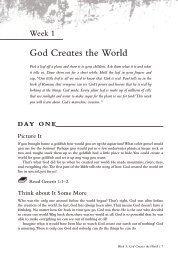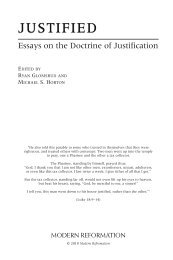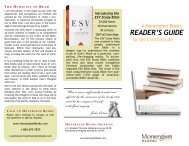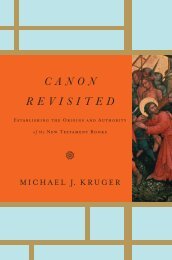Knowing Scripture r. c. Sproul - Monergism Books
Knowing Scripture r. c. Sproul - Monergism Books
Knowing Scripture r. c. Sproul - Monergism Books
Create successful ePaper yourself
Turn your PDF publications into a flip-book with our unique Google optimized e-Paper software.
e v i s e d E d i t i o n<br />
K now i ng<br />
<strong>Scripture</strong><br />
R. C. <strong>Sproul</strong><br />
Foreword by J. I. Packer
Contents<br />
Foreword by J. I. Packer . . . . . . . . . . . . . . . . . . . . 9<br />
Preface . . . . . . . . . . . . . . . . . . . . . . . . . . . 13<br />
1 Why Study the Bible . . . . . . . . . . . . . . . . . 15<br />
Two Myths . . . . . . . . . . . . . . . . . . . . . . . 15<br />
The Clarity of <strong>Scripture</strong> . . . . . . . . . . . . . . . . . 17<br />
The Problem of Motivation. . . . . . . . . . . . . . . . 20<br />
The Biblical Basis for Bible Study . . . . . . . . . . . . . 22<br />
The Bible as Revelation. . . . . . . . . . . . . . . . . . 26<br />
Theory and Practice . . . . . . . . . . . . . . . . . . . 28<br />
The Sensuous Christian . . . . . . . . . . . . . . . . . 30<br />
A Matter of Duty . . . . . . . . . . . . . . . . . . . . 35<br />
2 Personal Bible Study and Private Interpretation . . 36<br />
Martin Luther and Private Interpretation . . . . . . . . . 36<br />
Objectivity and Subjectivity . . . . . . . . . . . . . . . 41<br />
The Role of the Teacher . . . . . . . . . . . . . . . . . 45<br />
3 Hermeneutics: The Science of Interpretation. . . . 49<br />
The Analogy of Faith. . . . . . . . . . . . . . . . . . . 51<br />
Interpreting the Bible Literally. . . . . . . . . . . . . . 53<br />
Literal Interpretation and Genre Analysis . . . . . . . . . 54<br />
The Problem of Metaphor . . . . . . . . . . . . . . . . 59<br />
The Medieval Quadriga . . . . . . . . . . . . . . . . . 60<br />
The Grammatical-Historical Method. . . . . . . . . . . 62<br />
Source Criticism. . . . . . . . . . . . . . . . . . . . . 64<br />
Authorship and Dating . . . . . . . . . . . . . . . . . . 65<br />
Grammatical Errors . . . . . . . . . . . . . . . . . . . 67<br />
4 Practical Rules for Biblical Interpretation . . . . . 69<br />
Rule 1: Read the Bible Like Any Other Book . . . . . . . 69
8 <strong>Knowing</strong> <strong>Scripture</strong><br />
Rule 2: Read the Bible Existentially. . . . . . . . . . . . 71<br />
Rule 3: Interpret the Historical Narratives by the Didactic. 76<br />
Rule 4: Interpret the Implicit by the Explicit . . . . . . . 83<br />
Rule 5: Determine Carefully the Meaning of Words . . . 87<br />
Rule 6: Note the Presence of Parallelisms . . . . . . . . 95<br />
Rule 7: Note the Difference Between Proverb and Law . . 99<br />
Rule 8: Observe the Difference Between the Spirit<br />
and the Letter of the Law. . . . . . . . . . . . . 101<br />
Rule 9: Be Careful with Parables . . . . . . . . . . . . . 105<br />
Rule 10: Be Careful with Predictive Prophecy . . . . . . 108<br />
Rule 11: Interpret the Bible with a Spirit of Humility . . . 111<br />
5 Culture and the Bible. . . . . . . . . . . . . . . . . 114<br />
Cultural Conditioning and the Bible . . . . . . . . . . . 114<br />
Cultural Conditioning and the Reader . . . . . . . . . . 117<br />
Principle and Custom . . . . . . . . . . . . . . . . . . 120<br />
Practical Guidelines . . . . . . . . . . . . . . . . . . . 122<br />
6 Practical Tools for Bible Study . . . . . . . . . . . . 128<br />
Bible Translations . . . . . . . . . . . . . . . . . . . . 128<br />
Study Bibles . . . . . . . . . . . . . . . . . . . . . . . 130<br />
The King James Version . . . . . . . . . . . . . . . . . 132<br />
Commentaries . . . . . . . . . . . . . . . . . . . . . 134<br />
Concordances, Bible Dictionaries and Atlases . . . . . . . 136<br />
Word Studies . . . . . . . . . . . . . . . . . . . . . . 137<br />
Foreign Translations . . . . . . . . . . . . . . . . . . . 138<br />
What About Greek and Hebrew? . . . . . . . . . . . . . 138<br />
Bible Software . . . . . . . . . . . . . . . . . . . . . . 141<br />
Bible Reading Program for Beginners. . . . . . . . . . . 142<br />
Conclusion . . . . . . . . . . . . . . . . . . . . . . . 145<br />
Notes . . . . . . . . . . . . . . . . . . . . . . . . . . . 146<br />
Glossary . . . . . . . . . . . . . . . . . . . . . . . . . . 150
Preface<br />
Recent years have seen a renewal of interest in the <strong>Scripture</strong>s.<br />
Since neo-orthodox theology called the church back to a serious<br />
study of the content of the Bible, there has been more concern in<br />
the life of the church for understanding and applying its message to<br />
our generation. Along with this new interest, however, has come<br />
confusion; there has been little agreement among Christian scholars<br />
concerning the rudimentary principles of biblical interpretation.<br />
This con fusion in the scholarly world has made an impact on<br />
the life of the whole church.<br />
Our day seems to be the age of “lay renewal.” Much of this renewal<br />
is associated with home Bible studies and small group fellowships.<br />
Many people now gather to discuss, de bate and comment<br />
on the <strong>Scripture</strong> for themselves. Often they find themselves disagreeing<br />
about what the Bible means or how it should be applied.<br />
This has had unfortunate consequences.<br />
For many, the Bible remains an enigma capable of vastly different<br />
interpretations. Some have even despaired of their own ability<br />
to make sense of it. To others the Bible has a nose of wax capable<br />
of being shaped into con formity with the vested interests of the<br />
SAMPLE—DO NOT COPY
14 <strong>Knowing</strong> <strong>Scripture</strong><br />
reader. Too often the conclusion seems to be, “You can quote the<br />
Bible to prove anything.”<br />
Is there any way out of this confusion? Can serious readers find<br />
any principles to guide them through the conflicting viewpoints<br />
they hear from all sides? These are some of the questions that this<br />
book is designed to deal with.<br />
Although many of the issues have a scholarly dimension, I have<br />
not been motivated by a desire to enter the academic debate concerning<br />
the science of hermeneutics. Rather my prime motivation<br />
is to offer basic, “common sense” guide lines to help serious readers<br />
study sacred <strong>Scripture</strong> profit ably. In line with the Bible’s own view<br />
of itself, the book seeks to emphasize the divine origin and authority<br />
of Scrip ture. Because of this, I have attempted to provide rules<br />
of interpretation that will serve as a check and balance for our alltoo-common<br />
tendency to interpret the Bible according to our own<br />
prejudices. The book closes with a survey of various tools that are<br />
available to help either beginners or more ad vanced students of the<br />
Bible. Above all, I would like this to be a practical book that will<br />
give assistance to lay people. Indeed, I have a fond hope that Christians<br />
will continue their study of the <strong>Scripture</strong> and continue the<br />
contributions they are making in the church. May this book be an<br />
encouragement to persevere with joy as well as understanding.<br />
I owe a debt of gratitude to a number of people who assisted me<br />
in this project, among them Prof. David Wells, whose ad vice has<br />
been invaluable in correcting the manuscript.<br />
R. C. <strong>Sproul</strong>


